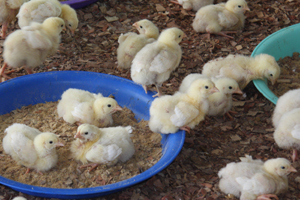High fibre effects on broiler, layer chick performance

ABSTRACT: Researchers at Iowa State University, USA, conducted an experiment to evaluate the effects of feeding various fibre contents on the performance of chickens bred for egg or meat production from 1-21 d of age.
The lower fibre diet was based on a traditional corn-soybean meal (SBM) diet and the higher fibre diet was formulated by the addition of 60 g/kg of both dried distillers grains with solubles (DDGS) and wheat bran in the first period of feeding and 80 g/kg of both DDGS and wheat bran in the second period of feeding to the corn-SBM base.
The diets were isocaloric and were formulated to meet or exceed NRC requirements.
Two lines of male chicks, Ross 308 broilers and Hy-Line W36 layers, were randomly assigned to cages with 11 replicates of 8 chicks for each of the 4 treatments. The evaluation criteria consisted of average daily gain (ADG), average daily feed intake (ADFI), feed efficiency (FE), nitrogen corrected apparent metabolisable energy (AMEn) and neutral detergent fibre (aNDF) digestibility.
The higher dietary fibre diet significantly reduced broiler ADG (P≤0.01) for the 1-12 d and 1-21 d periods but had no effect on layer chick ADG resulting in a significant interaction. Increasing dietary fibre did not have significant effects on ADFI for the 1-12 d and 1-21 d periods.
Neutral detergent fibre digestibility was higher in layer chicks than broiler chicks regardless of the diet (P≤0.01), and higher dietary fibre concentration resulted in increased ileal (P≤0.01) and total (P≤0.02) aNDF digestibility, across both lines. Apparent metabolisable energy was not different (P = 0.96) between lines or dietary fibre content. These results suggest that layer chicks are able to better utilise feed ingredients rich in fibre content compared to broiler chicks, possibly due to decreased ADFI and increased fibre utilisation.
Source: ScienceDirect











